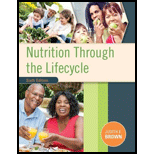
Nutrition Through the Life Cycle (MindTap Course List)
6th Edition
ISBN: 9781305628007
Author: Judith E. Brown
Publisher: Cengage Learning
expand_more
expand_more
format_list_bulleted
Concept explainers
Question
Chapter 5, Problem 7RQ
Summary Introduction
To examine: Whether the statement “It is recommended that women with diabetes gain 5 pounds (2.3 kg) less during pregnancy than the IOM-recommended, lower limit of their weight gain range bases on pre-pregnancy BMI” is true or false.
Introduction: Pregnancy complications are health problems that arise during pregnancy. Pregnancy complications like pregnancy-induced hypertension (PIH), preeclampsia, and gestational diabetes are associated with several risks for pregnant women as well as the child before and after birth. These conditions usually resolve after birth of the baby.
Expert Solution & Answer
Want to see the full answer?
Check out a sample textbook solution
Chapter 5 Solutions
Nutrition Through the Life Cycle (MindTap Course List)
Ch. 5 - Prob. 1.1CSCh. 5 - Prob. 1.2CSCh. 5 - Prob. 1.3CSCh. 5 - Prob. 2.1CSCh. 5 - Prob. 2.2CSCh. 5 - Prob. 2.3CSCh. 5 - Prob. 2.4CSCh. 5 - Prob. 2.5CSCh. 5 - Prob. 3.1CSCh. 5 - Prob. 3.2CS
Ch. 5 - Prob. 3.3CSCh. 5 - Prob. 3.4CSCh. 5 - Prob. 1RQCh. 5 - Prob. 2RQCh. 5 - Prob. 3RQCh. 5 - Prob. 4RQCh. 5 - Prob. 5RQCh. 5 - Prob. 6RQCh. 5 - Prob. 7RQCh. 5 - Prob. 8RQCh. 5 - Prob. 9RQCh. 5 - Prob. 10RQCh. 5 - Prob. 11RQCh. 5 - Prob. 12RQCh. 5 - Prob. 13RQCh. 5 - Prob. 14RQCh. 5 - Prob. 15RQCh. 5 - Prob. 16RQ
Knowledge Booster
Learn more about
Need a deep-dive on the concept behind this application? Look no further. Learn more about this topic, health-nutrition and related others by exploring similar questions and additional content below.Recommended textbooks for you
 Nutrition Through The Life CycleHealth & NutritionISBN:9781337919333Author:Brown, Judith E.Publisher:Cengage Learning,
Nutrition Through The Life CycleHealth & NutritionISBN:9781337919333Author:Brown, Judith E.Publisher:Cengage Learning, Nutrition Through the Life Cycle (MindTap Course ...Health & NutritionISBN:9781305628007Author:Judith E. BrownPublisher:Cengage Learning
Nutrition Through the Life Cycle (MindTap Course ...Health & NutritionISBN:9781305628007Author:Judith E. BrownPublisher:Cengage Learning- Essentials Health Info Management Principles/Prac...Health & NutritionISBN:9780357191651Author:BowiePublisher:Cengage

Nutrition Through The Life Cycle
Health & Nutrition
ISBN:9781337919333
Author:Brown, Judith E.
Publisher:Cengage Learning,


Nutrition Through the Life Cycle (MindTap Course ...
Health & Nutrition
ISBN:9781305628007
Author:Judith E. Brown
Publisher:Cengage Learning

Essentials Health Info Management Principles/Prac...
Health & Nutrition
ISBN:9780357191651
Author:Bowie
Publisher:Cengage

